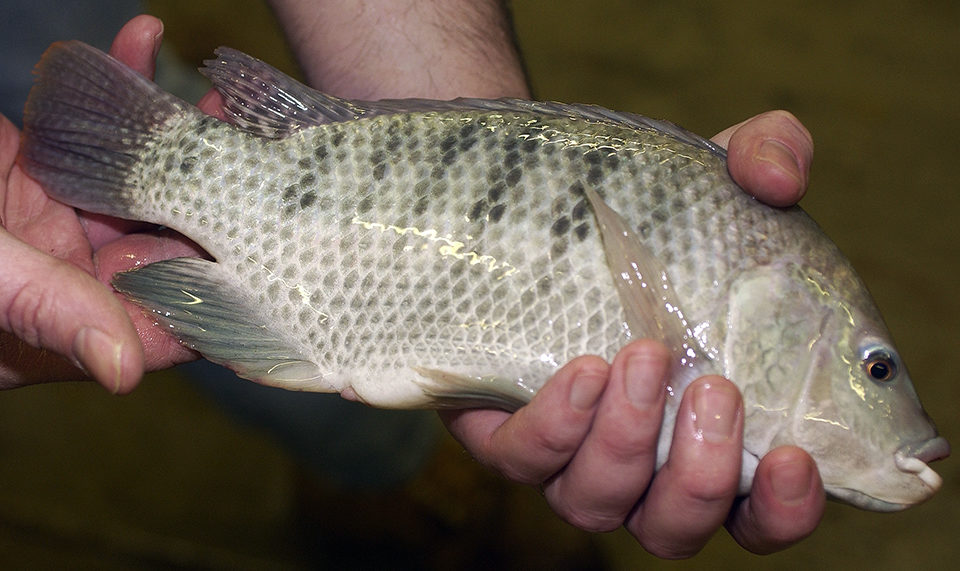Arsenic, other metals pose potential health risks

The microbial and chemical contents of foods involved in international commerce have recently received increased attention. Rapid industrialization combined with natural conditions in certain geographic areas have resulted in tilapia and other fish species becoming contaminated with biological agents and chemical compounds.
Imports are being increasingly tested for quality and safety by regulatory agencies and customers. Producers that do not employ appropriate quality assurance programs may have their products rejected for noncompliance. The penalties for noncompliance can range from temporary detention of products for testing to a total ban on importation.
Bacterial impacts
In a 2005 study, the microbiological flora in both brackish pond water and fish were determined at three different locations to identify microorganisms that could be pathogenic to the fish and also affect their storage life and quality (Table 1).
Flick, Bacteria measured in pond water, Table 1
| Sample Source | Microbial Population Ranges |
|---|---|
| Pond Water (cfu/ml) | 1.5 x 103-8.6 x 103 |
| Sediment (cfu/g) | 3.1 x 106-1.1 x 107 |
| Gills (cfu/g) | 1.9 x 105-0.9 x 106 |
| Intestine (cfu/g) | 2.4 x 107-1.6 x 108 |
In total, 19 bacterial species were identified, predominantly in the form of Gram-negative rods. In all the populations, the predominant bacterial species with prevalence of over 10 percent were Vibrio parahaemolyticus, V. carchariae, V. alginolyticus, Chryseomonas species, V. vulnificus, and Streptococcus species. The sediment population was an exception, where Streptococcus was replaced by Shewanella putrefaciens.
At 58 percent of the total isolates, vibrios dominated the total bacterial population. Other identified bacteria included Aeromonas hydrophila, Bacillus and Burkholderia species, Pasteurella pneumotropica, Photobacterium and Pseudomonas species, Serratia liquefaciens, Staphylococcus species, V. cholerae, V. fluvialis, and V. furnissii.
Gill diseases may be initiated by opportunistic bacteria already resident on animals’ gill surfaces. Streptococcus bacteria pose the most serious disease threat to the tilapia industry. Moreover, these bacteria have been known to pass from fish to humans who handled them.
If a disease outbreak occurs in a production system, Vibrio species proliferate, thereby increasing the possibility that all fish will be infected. The high incidence of vibrios in ponds and on fish can create a problem if the culture water for tilapia is subsequently used to grow another aquatic species. Shrimp and marine fish such as sea bream, sea bass, and turbot are susceptible to vibriosis disease.
Human effects
V. parahaemolyticus is a common foodborne disease pathogen of aquatic origin in which infections have been related to the consumption of farmed finfish. However, the bacteria are more closely associated with the culture of oysters and other mollusks.
A new biotype of V. vulnificus caused hundreds of serious infections among persons who handled live tilapia produced in Israel. Infections by this bacterium are serious in immunocompromised individuals – mortalities can approach 48 percent.
Aeromonas hydrophila is an opportunistic pathogen for individuals whose health has been previously compromised. Certain Streptococcus infections have occurred in individuals who worked in recirculating aquaculture facilities. These bacteria can be serious, since many have become highly resistant to both traditional and new antibiotics.
Product quality
While some bacteria are pathogenic to aquacultured animals and humans, others could have an impact on product quality and safety. Some strains of Shewanella putrefaciens, for example, are capable of producing strong and offensive off-odors or flavors, which result in consumer rejection of the product. This is somewhat analogous to the earthy or muddy off-flavor or odor problem caused by the presence of compounds such as geosmin or methylisoborneol.
During processing operations, bacteria from the intestines, gills, and surfaces of fish are commonly transferred to processed products, regardless of the level of automation used in the processing operation. Pseudomonas is a facultative group of bacteria that results in food spoilage even if the product is stored at temperatures below 2 degrees-C.
Chemical impacts
Arsenic contamination of groundwater is a major environmental concern in some countries. High arsenic concentrations in well water have been associated with blackfoot disease and other human illnesses. In some areas, arsenic concentrations top 0.30 ± 0.35 mg per liter in 95 percent of the well water, far exceeding the World Health Organization guideline of 0.01 mg per liter. While much of the well water containing arsenic is not directly ingested by most inhabitants in the problem regions, it is still used extensively in aquaculture.
Tilapia, like many fish species, accumulate arsenic in their tissues. The inorganic arsenic concentrations in farmed fish increase as the arsenic concentration of pond water increases, causing a potential cancer risk for fish and consumers alike. Decreased survival and reproductive ability observed in the fish were related to the accumulation of metals in the aquatic organisms.
Pond water taken from certain rivers may also be significantly contaminated with polycyclic aromatic hydrocarbons (PAHs), dichloro-diphenyl-trichloroethane (DDT), and three toxic metals; cadmium, chromium, and lead. Tilapia grown in waters contaminated with these chemicals ormetals could present a health risk to consumers.
The results of a 2005 study of chemical contamination in tilapia fillets showed that total PAHs ranged 15.1-92.5 ng per gram. There is no U.S. standard for the presence of this pollutant. Total DDTs ranged 0.53-31.70 ng per gram, which exceeded the 14.40 ng per gram concentration permitted by the United States Environmental Protection Agency. If the maximum tolerable intake level for DDTs is considered, the amount of fish that can be safely consumed is less than a typical serving size. Concentrations for the three metals and allowable levels are contained in Table 2.
Flick, Cadmium, chromium, and lead, Table 2
| Chemical | Concentration (ng/g) | Allowable Concentration (ng/g) | Location |
|---|---|---|---|
| Cadmium | < 0.01-298.00 | 1001 | Europe |
| Cadmium | < 0.01-298.00 | 2002 | Australia, New Zealand |
| Cadmium | < 0.01-298.00 | 2,0003 | Hong Kong |
| Chromium | < 0.01-884.00 | 5004 | China |
| Chromium | < 0.01-884.00 | 1,0003 | Hong Kong |
| Lead | 507.00-3,519.00 | 4001 | Europe |
| Lead | 507.00-3,519.00 | 5002 | Australia, New Zealand |
| Lead | 507.00-3,519.00 | 6,0004 | Hong Kong |
Depending on the amount of fish consumed by a specific population, fish containing elevated levels of these three metals could present a health hazard. Ponds containing the greatest amount of the organic and inorganic pollutants were most often found in geographic regions experiencing rapid socioeconomic growth.
(Editor’s Note: This article was originally published in the January/February 2008 print edition of the Global Aquaculture Advocate.)
Now that you've reached the end of the article ...
… please consider supporting GSA’s mission to advance responsible seafood practices through education, advocacy and third-party assurances. The Advocate aims to document the evolution of responsible seafood practices and share the expansive knowledge of our vast network of contributors.
By becoming a Global Seafood Alliance member, you’re ensuring that all of the pre-competitive work we do through member benefits, resources and events can continue. Individual membership costs just $50 a year.
Not a GSA member? Join us.
Author
-

George J. Flick, Jr., Ph.D.
Food Science and Technology Department
Virginia Tech/Virginia Sea Grant (0418)
Blacksburg, Virginia 24061 USA[117,100,101,46,116,118,64,103,107,99,105,108,102]
Tagged With
Related Posts

Health & Welfare
A comprehensive look at the Proficiency Test for farmed shrimp
The University of Arizona Aquaculture Pathology Laboratory has carried out the Proficiency Test (PT) since 2005, with 300-plus diagnostic laboratories participating while improving their capabilities in the diagnosis of several shrimp pathogens.

Health & Welfare
A holistic management approach to EMS
Early Mortality Syndrome has devastated farmed shrimp in Asia and Latin America. With better understanding of the pathogen and the development and improvement of novel strategies, shrimp farmers are now able to better manage the disease.

Responsibility
A look at various intensive shrimp farming systems in Asia
The impact of diseases led some Asian shrimp farming countries to develop biofloc and recirculation aquaculture system (RAS) production technologies. Treating incoming water for culture operations and wastewater treatment are biosecurity measures for disease prevention and control.

Health & Welfare
A study of Zoea-2 Syndrome in hatcheries in India, part 1
Indian shrimp hatcheries have experienced larval mortality in the zoea-2 stage, with molt deterioration and resulting in heavy mortality. Authors investigated the problem holistically.


